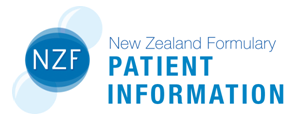What does it do?
Hyoscine hydrobromide patches are used to treat and prevent nausea, vomiting and dizziness. They are also sometimes used for other conditions.
Before you start
- Tell your doctor if you have liver, bowel, prostate or bladder problems, or if you have angle-closure glaucoma.
- Tell your doctor if you are pregnant, planning to become pregnant, or breastfeeding.
How should you use it?
Apply the patch to the skin behind your ear. It will start to work in 5 to 6 hours and last up to 3 days.
Remove the patch when no longer required, or, if you need to use the patch for longer than 3 days, remove it and apply a new one behind your other ear.
Do not cut the patch.
Wash your hands after handling the patch to prevent hyoscine hydrobromide accidentally getting into your eyes.
What if you forget a dose?
If you forget to change the patch, remove the old patch and apply a new one as soon as possible.
Can you take other medicines?
Some medicines available without a prescription may react with hyoscine hydrobromide including:
- some antihistamines (may be in anti-allergy, anti-nausea and cough/cold medicines)
- other medicines that may cause drowsiness (e.g. pain-killers, anti-nausea and cough/cold medicines – ask your pharmacist)
Tell your pharmacist or doctor about all medicines or treatments that you may be taking, including vitamins, herbal products (e.g. valerian) or recreational drugs.
What side effects might you notice?
| Side Effects | Recommended action |
|---|---|
|
Fast or irregular heartbeat |
Tell your doctor immediately |
|
Confusion |
Tell your doctor |
|
Dry mouth, blurred vision, constipation or trouble peeing (anticholinergic effects) Drowsiness, dizziness, restlessness Flushing Red or itchy skin where patch has been applied |
Tell your doctor if troublesome |
If you notice any other effects, discuss them with your doctor or pharmacist.
Other information:
- Some procedures (e.g. MRI scan) may overheat the patch and burn your skin. Discuss with your health professional before your procedure.
- Hyoscine hydrobromide can impair your ability to do tasks such as driving or using machines. This may last for 24 hours or longer after the patch is removed. Alcohol makes this worse. Discuss your risk with your health professional. (search NZTA - Are you safe to drive?)
- Dispose of hyoscine hydrobromide patches by folding the patch in half with the sticky sides together. Make sure to dispose of it out of the reach of children.
- Hyoscine hydrobromide is also sometimes known as scopolamine.
This leaflet contains important, but not all, information about this medicine.
Prepared by the MyMedicines Committee at Christchurch Hospital, Te Whatu Ora - Waitaha, New Zealand. March 2023
For more general information about this sheet and its contents, see: What does a My Medicines sheet cover?
Te Reo Māori
Te Reo Māori information sheets supported by Health Quality and Safety Commission New Zealand
Web links for this sheet in different formats
Click on buttons to copy web addresses for this leaflet:
If your browser does not automatically copy these links use its copy command instead.
About My Medicines
My Medicines Patient Information Leaflets (PILs) contain important, but not all, information about the medicines they describe.
For more information about the sheets, see: What does a My Medicines sheet cover?
My Medicines is developed by a team at Te Whatu Ora – Waitaha. Our team is made up of doctors, pharmacists, and a non-medical person to help us keep to plain language. We also discuss our information with specialist health professionals or groups when needed

